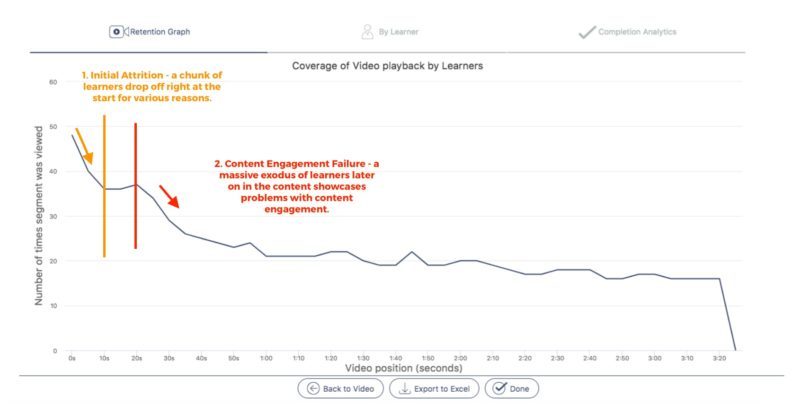Delivering Better Learning Experiences With The Help Of Learning Content Analytics
An area where Learning and Development professionals could learn a lot from, e.g. marketing experts, is content analytics. Whereas marketing has embraced the need to constantly iterate and redevelop content based on real-time campaign analytics, learning professionals tend to take the easier route. Once an eLearning activity is produced and published, it's easy to just leave it there and be done with it.
But the work is really only at its midway. How do you find out if the content resonated with the audience or not? If it didn't, how do you figure out what are the problem areas with the content? This is where learning content analytics come in handy.
Example Of Learning Content Analytics On A Training Video
When analyzing the effectiveness of eLearning content, you should pay attention to what kind of metrics you are tracking. For instance, in the case of a training video, traditional metrics like how many times the video was opened don't necessarily carry a lot of value. Instead, we should be looking at the content consumption behavior on a wider scale, throughout the content and the learning journey. Let's take a look at an analytical view of a training video.

In this example, you can see the users' behavior at various stages of the training video. As usual, you see a slump immediately in the beginning, followed by another bigger slump later on. We've colored the 2 main points of interest to break them down.
1. Initial Attrition
You are always bound to lose some learners in the beginning due to a plethora of reasons. However, if you constantly see big drops starting from 0 seconds, you might want to double-check, e.g. the loading times of the content, to make sure your learners are not quitting because of inability to access the material in a timely manner.
2. Learning Content Engagement Failure
Going further in the video, we see another big slump where we lose around 40% of the remaining learners in just 30 seconds. Clearly, this represents a learning engagement failure. Something is not right there. Learners are likely dropping off because the content is not engaging, relevant or presented in an appealing way.
How Should I Incorporate Content Analytics In The eLearning Development Process?
The above-mentioned video analytics is just a single example of how you can use content analytics to support your learning. Ideally, you should be running these kind of analytics across all your learning content. xAPI tracking capabilities give a lot of possibilities in this regard. Once you're collecting the data and running the analytics, this is how you could build the use of analytics into your eLearning development process:
1. Develop an initial version of eLearning materials
2. Roll it out to a test group of learners, monitor the analytics
3. Identify potential learning engagement failures and re-iterate content accordingly
4. Mass roll-out to a wider audience
5. Revisit the content analytics at regular milestones (e.g. when a new group of learners is assigned the content) to ensure continued relevance and engagement
This type of approach helps to ensure that the learning activities you provide and invest money in, perform at their best at all times.
How Can I Use Learning Content Analytics To Provide Better Learning Experiences?
By now, you've surely developed many use cases for content analytics. To summarize, here's how you could provide a better learning experience through data-driven insights:
1. Identify The Types Of Content Your Learners Like
In the case of videos, you could benchmark the performance of different types of videos (e.g. talking heads, animations, storytelling videos) against each other and see what type of content keeps your learners engaged the best.
2. Develop Engaging Content
With the power of analytics, you'll be able to develop better learning. You are able to find out immediately what works and what doesn't. No need to run extensive surveys. The behavior of the learners is the best feedback.
3. Personalize Learning Experiences
You can naturally run analytics for individuals and defined groups, in addition to the whole mass of learners. This helps you personalize the learning experiences according to e.g. skill levels, seniority, experience, previous learning history, etc.
All in all, learning content analytics provide a powerful tool for increased transparency and visibility into the performance of your eLearning. As learning moves to more in-demand and just-in-time, they help to ensure that you're delivering the right content to the right audience.









